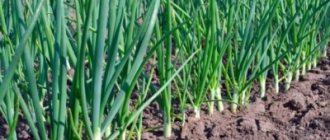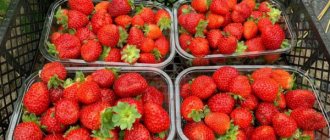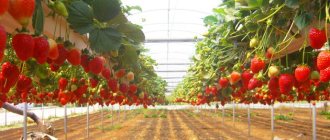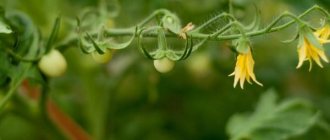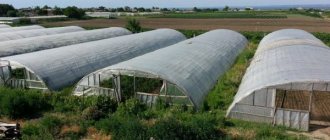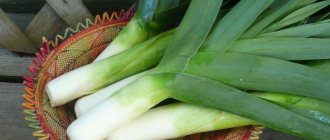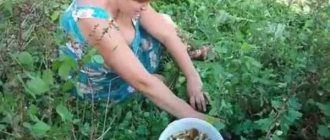In the current economic situation, it is more profitable to start your own business than to depend on external circumstances. Drawing up a business plan for a greenhouse for growing vegetables will not be difficult if you decide in advance on the parameters of the greenhouse, the products to be grown, the sales market and the amount of money invested.
Greenhouse farming
Preparation of a business plan
This document makes it possible to take out a loan or get the state to invest money free of charge in your business. Having a detailed plan saves time and increases productivity. Business planning will protect you from mistakes that can be made when organizing a business.
Video – Greenhouse business plan
To correctly draw up a plan, you need to know its structure and become familiar with the features of growing vegetables in a greenhouse. Only then can you count on profit. The selection of products is carried out taking into account the following criteria:
- climate of the area;
- demand for vegetables;
- implementation options.
How to choose a site for a greenhouse business
Important! Decide how you will do business - all year round or only in season, buy ready-made seedlings or grow them yourself. But the key will still be the amount of money you want to invest in your business.
Before drawing up a project, the goals are clearly defined. When planning a greenhouse business, they may sound like this:
- Organization of greenhouse farming for retail and wholesale trade in the region.
- Receiving a profit in the amount of N million rubles. in year.
- Expanding the product range to include rare vegetable crops for sale to restaurants.
Kiwano or African cucumber
The business plan must include information about the owner, the direction of activity and the location of the facility.
Kiwano seeds prices
kiwano seeds
Selection of seed material for seedlings
The product range consists of the earliest and most popular types of seedlings among summer residents and gardeners: cucumbers, tomatoes, eggplants, cabbage, basil, bell peppers and other vegetable crops. Then seedlings of later varieties of vegetables and flower plants go on sale.
The initial technological stage of growing seedlings is the selection and purchase of seed material. Seeds play an extremely important role in obtaining the final result - strong, high-quality, green seedlings, attractive in appearance and yielding a large yield of products.
Seedlings are grown from varietal seeds. Varietal seeds are those that have been bred through many years of selective selection and correspond to a specific crop and variety. Varietal seeds on bags and packages are marked S with a number that indicates the generation of the variety. Seeds marked S1 (first generation seeds) have the best quality.
Strawberry seeds marked S1
There are also hybrid varieties obtained from crossing several parent varieties in order to improve certain qualities. It is very simple to identify them by the inscription on the packaging: after the name of the variety they are marked F1 (first generation hybrid). Good seedlings and fruits grow from such seeds, but seeds from hybrid fruits will produce products without improved characteristics, worse than their predecessors. In addition, they are distinguished by their unpredictability and higher price. Hybrid cucumbers, for example, can produce a good harvest in the first weeks, but then simply dry out. All this will negatively affect your reputation. Customers will leave you in search of better seeds to competitors.
Cucumber seeds marked F1
A growing business is profitable only if you sell seedlings in thousands or tens of thousands of pieces. Therefore, you will have to buy a lot of seeds. Bags of 1-2 grams of products will not suit you. Thus, 1 gram of medium seeds (cabbage, tomatoes) contains only 200-400 seeds.
They buy varietal seeds in bulk from specialized stores and from wholesalers who have been trading in the seed market for several years. You can also buy them at seed institutes, state farms, and farmers. This way you will save money and purchase genuine and high-quality products. You need to buy in January, later the cost of the material will begin to increase.
It is advisable to purchase in bulk only those varieties that are bred for your region, the so-called zoned varieties. They are adapted to the climate of the area and the nature of the local soil, are more predictable and are most famous among local gardeners and gardeners. Therefore, you need to find out the varieties that are in greatest demand before purchasing seeds. You can study the demand at the local market, where you will also sell your product.
Check the expiration date. The optimal shelf life of green seeds is up to 2 years; carrots, radishes, cabbage – up to 5 years; for legumes, pumpkins, cucumbers, and tomatoes it is even higher.
We decide on the timing of sowing seeds. It is better to plant in 3 stages with a time interval of 10 days. Sales start from mid-April until the end of May, with the peak usually occurring during the May holidays. Count back a month and a half from the start of sales - this will be the start of your planting work. After ten days, move on to the second stage - plant the next batch, etc.
Advantages and disadvantages of greenhouse farming
Before planning a business, it is advisable to weigh the pros and cons of growing vegetables for sale. This will help to draw a conclusion about its profitability.
Table 1. Pros and cons of the greenhouse business.
| pros | Minuses |
| Possibility to collect 2-3 crops | Tough competition |
| Quick income and payback | Sales depend on seasonality |
| Continuous demand | Short shelf life |
| Wholesale and retail trade | To grow vegetables all year round you will need additional equipment |
| Easy organization | To sell products to stores you will need a special permit |
| There is an option to start a business from home | Low prices for vegetables in the summer |
If you focus on vegetarians and adherents of a healthy diet, demand for products is guaranteed at any time of the year. During the winter period, the interest in vegetables among this audience remains unchanged, and their prices increase significantly.
What you need to start
How to start a seedling business. To do this, you need a plot of land on which greenhouses, a shed for storing boxes and equipment should be located. Growing seedlings and strawberries for sale requires at least 12 acres of land. If you are the owner of a summer cottage or personal plot, you can start a home business on a small scale.
Arched polycarbonate greenhouse on a summer cottage
In order to avoid problems with the tax service, it is better to register a business in growing seedlings in the form of an individual entrepreneur and choose a simplified tax regime. This type of activity does not require a license.
Which products to choose?
You can grow different vegetables - exotic or traditional for your region. The most popular options among local crops include:
- beets, carrots, potatoes;
- cucumbers, tomatoes, peppers;
- cabbage
You can read more about growing tomatoes in a greenhouse in our article.
Cabbage is the most unpretentious vegetable
These vegetables do not require special storage and cultivation conditions. Caring for them does not cause much trouble.
Important! The degree of exoticism of vegetables directly affects their cost. If a crop is not typical for a given area, care will have to be taken to create the appropriate conditions for it. This will require additional costs, and due to low demand, the problem of loss of presentation may arise.
When choosing products, you should not ignore customer requests. In the early stages of work, it is better to focus on vegetables that are in demand among consumers throughout the year.
Prices for cabbage seeds
cabbage seeds
Financial side of the issue
A financial plan is a forecast of current investments. Without them, the vegetable growing business is doomed to failure. You will need the ability to calculate expected and actual profits. All expenses are divided into three categories - one-time, variable and permanent.
Accounting for investments is a mandatory component of a business plan
The first category includes:
- preparation of documentation, business registration;
- renting a plot of land;
- design and construction of greenhouses;
- purchase of garden tools and equipment;
- purchase of planting material and fertilizers.
Buying ready-made seedlings is a good alternative to growing vegetables from seeds
This will take 2-3 months. The total amount of one-time investments will be 15-18 million rubles. If you have your own land plot, you will need 4-5 million rubles to open a business.
Important! Decide how many greenhouses you plan to build. If you sell products in small quantities, it is enough to register as the owner of a personal subsidiary plot. If you are not an individual entrepreneur, you do not need to pay taxes.
Table 2. Monthly expenses.
| Attachment category | Price |
| Wages, insurance premium | 160 thousand rubles. |
| Communal payments | 100 thousand rubles. |
| Depreciation | 10 thousand rubles. |
| Plant protection from pests | 10 thousand rubles. |
| Organizational expenses | 70 thousand rubles. |
The total amount is 350 thousand rubles.
Variable costs include investments of different sizes. They are periodic. This could be the repair of greenhouses and equipment, the purchase of fuel for the delivery of vegetables. Based on the data provided, it is recommended to calculate the amount of monthly costs and for the year as a whole.
One of the costs is the repair of greenhouses
Competition Analysis
Taking into account its level is necessary in order to take a comprehensive approach to drawing up a business plan. In general, competition in the field of greenhouse farming is low. To analyze it, you need to collect data on everyone involved in growing vegetables for sale in your region.
How to analyze your competitors' business
The activities of entrepreneurs are considered according to the following criteria:
- name of the products grown;
- volume of goods offered for sale;
- degree of customer satisfaction with the quality of vegetables;
- what products are in demand?
A shopping pavilion is a clear example of analyzing demand and assortment
After the analysis, you can draw a conclusion about how profitable your greenhouse farming will be. After all, given the competition, no one guarantees that cooperation with large wholesale customers will last for a long time, and that the vegetables chosen for cultivation will be in demand.
How to face competition
After analyzing the competitive landscape, it's time to start developing your advantages. These could be the following measures:
- reduction in product prices;
- quality assurance;
- release of a catalog indicating favorable conditions and assortment;
- compiling a list of potential clients and then sending them your commercial offers;
- loyal discount system.
Competition is a continuous process, so it wouldn’t hurt to hire a specialist. His responsibilities will be to search for clients, analyze the activities of competitors, and promote advertising events.
Hiring a marketer is a guarantee of your success
How much profit can you get from growing vegetables?
The level of income is influenced by the seasonality factor. Most often, prices for agricultural products reach their maximum in spring and winter. If grown tomatoes or cucumbers are sold during this period, their cost will be in the range of 80-120 rubles. for 1 kg.
If you focus on a greenhouse with an area of 1000 sq.m. with a harvest of 16 tons per month and a price of 80 rubles. for 1 kg we hope for 100% of its implementation, the monthly income will be 1.28 million rubles.
Greenhouse with an area of 1000 sq.m.
To calculate net profit, you need to subtract constant investments from this amount - 350 thousand rubles. The result will be 930 thousand rubles. You can only have income of this size for six months. During the warm season of the year, the cost of production decreases several times. But even taking this into account, the project will pay for itself in 9-12 months if everything is organized correctly.
Soil for growing seedlings for sale
It is better to use turf soil for seedlings. It is prepared in advance in the spring, collected from ownerless meadows and forest edges. The collected soil is placed in ridges, periodically watered and kept under an opaque film until autumn. Over the summer it will rot and turn into light sandy loam, suitable for use. All that remains is to disinfect it: remove weeds, bacteria and other unnecessary elements from the soil.
Soil is of great importance for growing high-quality, strong seedlings
In industrial greenhouses, a steam generator is used when the soil is treated with steam over fairly large areas. A cheaper option is calcination over an open fire in metal trays, but without fanaticism, the earth must remain a living organism.
You can fertilize the planting soil with peat and compost from local soil.
Probability of risk
In the process of growing products indoors, you may find yourself at risk. When doing business, certain circumstances may arise that result in financial damage:
- Changes in energy prices. If tariffs rise and vegetable cultivation continues into the winter, income cannot always cover the cost of heating the greenhouse.
- Market dynamics. It needs to be taken into account - if cabbage is harvested well this year, this does not mean that next year you can earn a lot of money from selling it. Competitors can reduce prices or diversify their range at any time.
- Development of diseases, pests. If you do not regularly monitor the condition of the plants and do not take timely measures to protect them, 2-3 days are enough to lose the entire harvest.
Aphids are farmers' worst enemy
Important! If there is a possibility of risk, do not be afraid of it and stop trying to organize your business. Trial and error is also a valuable experience on the path to success.
Video – Greenhouse business of the Hertz family
Taking into account the risks and likely changes, the business plan will be more in line with reality.
Where can I grow seedlings for sale?
Growing seedlings as a business is carried out in a greenhouse. As a rule, two methods are used: growing seedlings in cups and directly in boxes. Seedlings in cups take root better and are convenient to transport. Boxes allow you to save space: 300 seedlings can be grown in a standard box. They are installed in the greenhouse on two levels, which allows for maximum production output per square meter of greenhouse area.
Seedlings in boxes
Recruitment
The business plan should contain detailed information about the personnel. This applies to positions, the number of employees, their responsibilities, and salary. In the future, the plan indicates the accepted work schedule and expected vacation dates.
To service a medium-sized greenhouse, 3-4 hired workers are enough. The list of their responsibilities will include:
- planting and caring for crops;
- harvest;
- sorting, packaging of products;
- maintaining the greenhouse in proper condition.
Plant care
Staff wages can be piecework-bonus or fixed. In the first case, it will be approximately 25 thousand rubles. for one person. Examples of fixed wages are presented in the table.
Table 3. Examples of fixed wages for employees.
| Job title | Quantity | Salary size |
| Manager | 1 | 40 thousand rubles |
| Technologist | 1 | 30 thousand rubles |
| Workers | 4 | 20 thousand rubles |
If an entrepreneur himself copes with the responsibilities of a manager and technologist, he will not have to spend extra money on wages and time to find people for these positions.
Expenses:
| No. | Name of expense item | Plan. amount, rub. | Note |
| Vegetable and flower seeds | 10000 | Vegetables - Dutch companies, flowers - f. Zedek | |
| fertilizers and stimulation agents | 1000 | ||
| cassette | 6000 | ||
| Primer and filler | 1000 | ||
| Film greenhouse | 10000 | Available | |
| Arched greenhouse SPK | 30000 | ||
| Garden wheelbarrow | 1800 | ||
| PET water barrel 220l | 2300 | ||
| Irrigation hoses 3/4″ 25 m with connector | 2200 | ||
| Drip irrigation system | 3500 | ||
| Composter 800l | 2000 | ||
| Waste shredder BOSH | 8000 | ||
| Lamps for additional illumination of seedlings | 1000 | ||
| Spunbond (non-woven material), PET film | 2600 | ||
| IR emitter 0.7 kW | 2300 | ||
| Email heated the water. ELECTROLUX | 5000 | ||
| Biological products for the composter | 1200 | ||
| Specialist. Literature on plant growing and floriculture | 1000 | available | |
| computer | 20000 | —«— | |
| Color printer | 5000 | —«— | |
| Printer consumables (paint, paper) | 1000 | —«— | |
| Computer software for 3D modeling and design projects | 5000 | ||
| 3-month courses in landscape design, Ekaterinburg | 9800 | ||
| Individual entrepreneur registration | 1000 | ||
| Total: | 132700 | ||
| Including subsidy funds 58,800 rubles, own funds 73,900 rubles (equipment and materials worth 37,000 rubles are already available) | |||
| Items on which subsidy funds are planned to be spent are highlighted in bold. |
Features of consumer search
The establishment of distribution channels begins from the moment the greenhouses are erected or long before that. This way you can avoid downtime and guarantee stable profits throughout the year. Vegetables have a short shelf life, so it is recommended to find 2-3 options at a time.
Wholesale bases
The less ripe vegetables are stored in greenhouse warehouses, the greater their chances of being sold. Otherwise, the price falls, and you have to worry about delivering the products to the sales points. Delivering goods to a wholesale base is the most profitable way to achieve 100% sales of vegetables.
Wholesale base
Resellers
Their priority is to have their own transport. You do not have to waste time and money on delivery of goods. The only negative is that some of them significantly reduce the price. Therefore, it is better to deal with several resellers so that you have a choice.
Processing plants
Regular emphasis on the production of canned products requires a continuous supply of new raw materials. The benefit of cooperation with processing enterprises is that they can be supplied in large quantities at reasonable prices.
Retail Stores
This option is more difficult, but it is worth the effort to establish contacts with the owners and their representatives. Here you will have to take their recommendations into account. Delivery is carried out at the expense of the farmer.
Retail outlet
Cafes and restaurants
This requires the ability to build trusting relationships with people. But your advantage is that you can supply exotic products to restaurant establishments, the cost of which is higher than traditional crops.
Exotic vegetables for supply to a restaurant
Selling seedlings
Seedlings are ready for sale when the sprout height reaches 15 cm. The best days for selling goods: Friday and Saturday morning, when summer residents are preparing or are already leaving for their plots.
Selling seedlings is a key stage. The product must be sold as quickly as possible: it cannot be stored for a long time, and is in demand in literally a matter of days. Therefore, it makes sense to attract additional workers to sell your products. The main place of sale will be the local market, where you should already have a fixed retail location, and maybe several retail outlets. Take care to decorate the counter with photographs of future products from your varietal seedlings.
Selling seedlings at the local market
